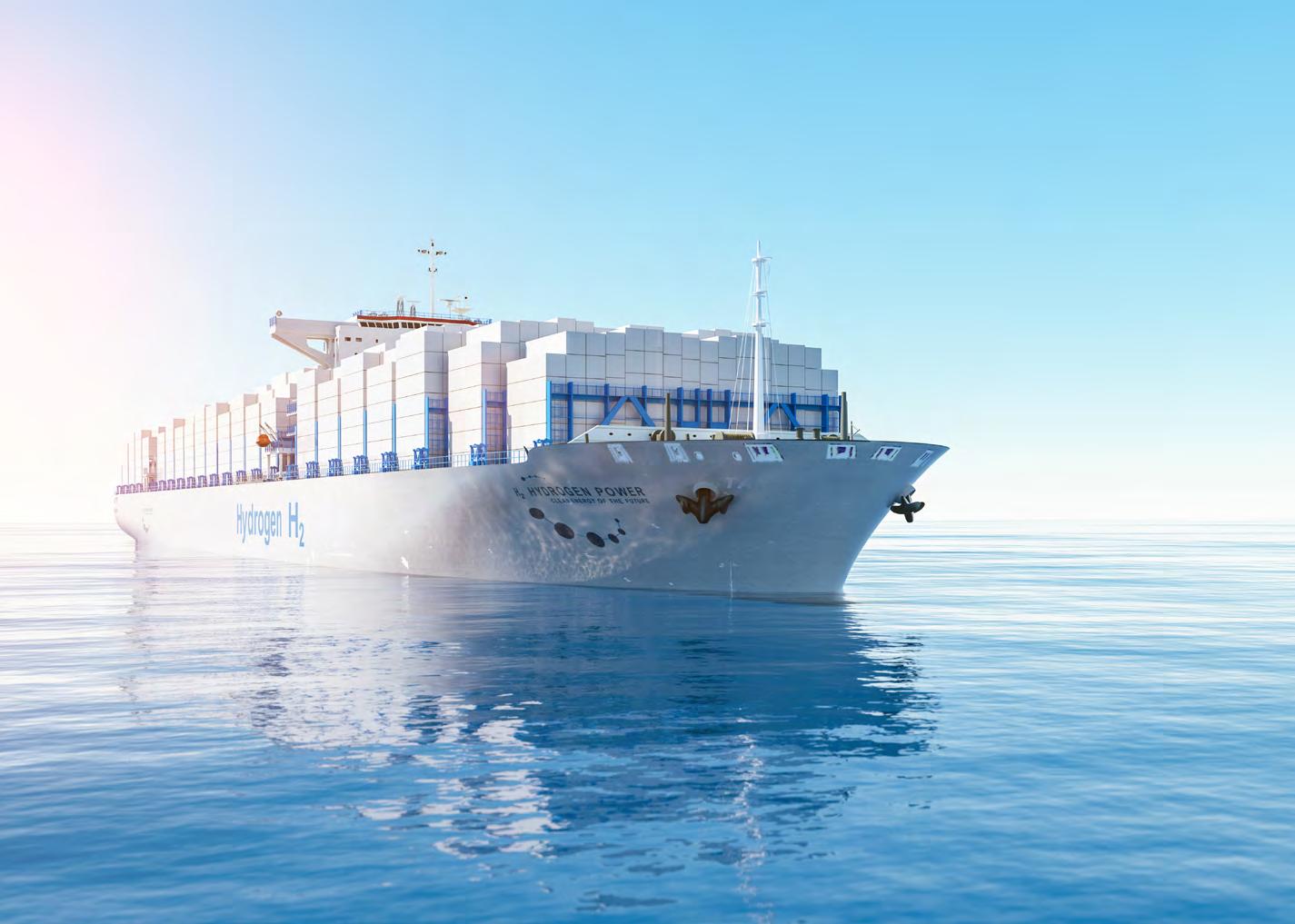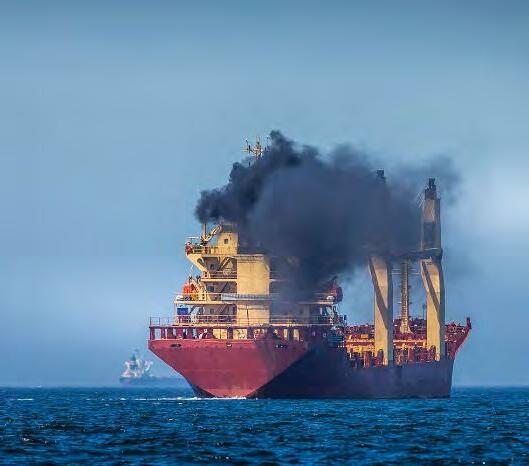
11 minute read
environment
from BTI Spring 2022
by Maritime-AMC
CLEAN LIVING
There have been a number of green initiatives in recent months aimed at reducing emissions as well as reducing hazards when changing from one fuel to another
Aderco, a leading fuel treatment technology specialist has launched an app for iOS and Android, designed to support both onboard officers and crew, as well as shore-based staff with regard to the often complex subject of fuel quality, increased hazards during fuel changeover procedures, fuel lubricity and incompatibility of fuels, as well as the presence of catalytic fines and contaminants.
Olivier Baiwir, chief executive of Aderco, says: “We are super excited with our new app, which has been built entirely from inception to completion in just nine months, with the principal goals of offering ease of navigation, a fast download time and the ability for users to use the app offline, the latter being of particular importance for those serving at sea with potential connectivity challenges.”
With the maritime industry today swiftly moving towards intelligent digitalisation solutions and, in order to optimise assets and procedures in a sustainable way, key features of the Aderco app include: » Fuel competences, fuel types and fuel compliance, including VSLFO, HFO,
MGO and biofuel.
» Correct application of the
Aderco products. » A full support section encompassing onboard issues, FAQs, troubleshooting guide, a technical library, preventative treatment and curative treatment for both two stroke and four stroke engines. » Videos covering fuel incompatibility and stability, water and catfines, as well as bacteria and biodiesel (FAME). » Fuel data received directly into the app via VPS, the largest bunker fuel testing company for ship operators in the world, covering selected bunkering ports and duly incorporating a traffic light warning system. » Aderco offices, contact points, stock points and partners.
In addition to Aderco’s normal dayto-day activities, particular focus has concentrated in offering practical solutions and help for those ships which have become affected when experiencing fuel problems. Such issues requiring to be addressed invariably relate to fuel quality, including the areas of total sediment, pour point, cat fines, CCAI, viscosity, acid number and chemical contaminants, with typical challenges being sticking plungers, damaged injection valves, broken rings, cracked pistons and even bent connecting rods. To this end, the new app will help identify the fuel related issue.
In many cases, Aderco is able to help a ship suffering from fuel contamination get back to port safely, being the most effective short-term solution to engine contamination resulting from poorly blended fuels. Fuels with high sediment will result in excessive sludge in tanks, which can lead to engine fuel starvation due to blocked and inefficient filters.
Shore power for NSW
According to Australian transport minister David Elliott, New South Wales will be home to the world’s first 100% renewable energy shore powered shipping precinct, at the Bays Port in the heart of Sydney.
Elliott says Bays Port, which includes Glebe Island and White Bay, will be the first bulk shipping precinct fully supplied by shore power. The White Bay Cruise Terminal will also be the first shore powered cruise berth in the Southern Hemisphere.
“Our government is creating the ports of the future and in doing so transforming the communities in which they continue to operate,” he says.
“The first berth is set to come online in 2024, and will allow shore power capable ships to cut their diesel generators, and thereby reducing emissions, air pollution and noise levels whilst at port.
“Shore power is cleaner and quieter, minimising the impact of ships on neighbouring areas and ensuring our last remaining deep water harbour berths continue to operate sustainably into the future.”
In the Bays Port area alone, renewable shore power will remove up to 14,000 tonnes of carbon dioxide from entering the atmosphere over 12 months, the equivalent of taking more than 4,000 cars off the roads every year.
The Port Authority of New South Wales (NSW) chief executive Philip Holliday announced the net zero and shore power plan with the support of bulk shipping and cruise industry leaders.
“This is an historic partnership with the Port Authority of NSW investing over $60m to deliver this infrastructure as the first step, with port users already pledging to retrofit and build ships to take advantage of this technology,” Captain Holliday says.
“Delivering shore power will drive us even further than our already ambitious NSW net zero targets, of a 75 per cent emissions reduction by 2030 and be net zero by 2040.”
Fuel power
Classification society Bureau Veritas has released a new rule note on fuel cell power systems on board ships. The rule note covers safety requirements for ships using any type of fuel cell technology, providing rules for the arrangement and installation of fuel cell power systems and the delivery of electrical energy.
Over the past few years, fuel cells have proved to have strong potential to help decarbonise the maritime industry. The technology, which is based on an electrochemical reaction like that in batteries, can run continuously without recharging as long as energy is provided. Fuel cells can bring significant environmental benefits, eliminating nitrogen oxide, sulphur oxide and particle emissions, while reducing

CO2 emissions, compared with diesel engines. However, this technology comes with a number of challenges that must be addressed to ensure safety.
Bureau Veritas’ NR 547 outlines requirements on the design, construction and installation of fuel cells systems to ensure that the safety of the ship is maintained. The aim is to identify and mitigate risks to persons on board, the environment and the structural integrity of vessels. Fuel cell systems and ship design must limit the risk of explosions, the spread of toxic chemicals and fire outbreaks.
Among the requirements outlined by NR 547, maritime stakeholders developing and using fuel cells must carefully assess the risks associated with their design, from construction to installation and operation.
Shipyards and equipment manufacturers have to meet specific safety requirements to earn certification for fuel cell systems. Once fuel cells are integrated onboard, ship operators must safeguard crew and ensure proper handling of fuel cell equipment. An extensive range of risk assessments are required for the fuel cell additional service feature to be granted.
These assessments include a Hazard Identification (HAZID) study of fuel cell spaces, a Hazard and Operability analysis (HAZOP) study of the fuel cell power system, and a Failure Mode and Effect Critical Analysis (FMECA) of the fuel cell power installation (if used for essential services).
In addition to covering fuel cells using hydrogen, the new note rule addresses fuel cells technologies that are adapted to multiple alternative fuel types, each with their own risk profile.
Laurent Leblanc, senior vice president technical & operations at Bureau Veritas Marine & Offshore, comments: “Our new rule responds to the latest advances in fuel cell technology, and incorporates information from the most recent industry-wide collaborations. For shipowners and operators taking the fuel cell route to sustainability, NR 547 lays the groundwork for operating safe, sustainable, and highperformance vessels.”
Bureau Veritas has released its new rule note NR 547 on fuel cell power systems on board ships, covering safety requirements for ships using any type of fuel cell technology.
Carbon capture on tugs
Value Maritime (VM), the emissionreducing tech entrepreneurs, and Carbon Collectors, specialists in collecting, transporting and storing CO2 safely, will together perform a conceptual design study for a new fleet of tugs to be built by Carbon Collectors.
VM will work together with Carbon Collectors to investigate the feasibility of capturing carbon onboard their new marine gas oil (MGO) fuelled tug vessels, using VM’s unique technology to ultimately ensure that Carbon Collectors’ fleet is CO2 neutral from the start.
Jointly, the two teams will investigate and determine: » The required installed power of the diesel generators. » The estimated CAPE /OPEX. » The best discharge options for the captured CO2. » The optimal solution for unloading and underground storage.
According to Christiaan Nijst, director and co-founder of Value Maritime: “This is a first for us. We’ve conducted many studies in relation to larger sea-going vessels but now Carbon Collectors are affording us the opportunity to apply our carbon capture expertise to tugs, extending the reach of our sustainable shipping solutions. We’re excited to see how these vessels will perform with our leading technology.”
Once the design is proven, Carbon Collectors aim to use Value Maritime’s carbon capture module to the fullest extent. It is currently designing a custom fleet of power-efficient tugs with the construction of the first vessels scheduled to start in the first quarter of 2024. Once operational by 2026, the MGO-fuelled tugs could be effectively capturing all of their CO2 emissions onboard.
Both parties will not only review the carbon capture abilities of the vessels but jointly look into the optimal solution

for safely unloading and permanently storing the CO2 underground.
Haije Stigter, technical director at Carbon Collectors comments: “As a company aiming to speed up the reduction of CO2 emissions, we also want to make sure that our own fleet contributes by becoming carbon-neutral as fast as possible. For years to come, carbon-neutral fuels will not be available in amounts that are large enough to fulfill demands, so carbon capture and storage seems the only feasible option in the short and medium term.”
VM developed Filtree, a unique system that cleans both air and water from all ship types and includes an integrated carbon capture feature making today’s fleet (newbuild or retrofit) not only sustainable today but future-proof for tomorrow.
The CO₂ capture feature removes and stores carbon from the vessel’s exhaust gases and uses it to charge a CO₂ battery, which can be offloaded and re-used to facilitate the growth of crops, used to enrich future fuels or it can be safely stored until needed – a truly clean circular solution.

Fuel cell power
ABB and Ballard are progressing with their industry-leading partnership to decarbonise marine transport and have received an Approval in Priniple (AiP) from DNV for their high-power fuel cell concept, the development of which was launched in 2018.
An AiP is a major milestone in developing new technology as an independent assessment of the concept, confirming that the design is feasible and no significant obstacles exist to prevent the concept from being realised.
With the AiP in place, the jointly developed solution can be completed within the next couple of years for application onboard a wide range of vessels.
“We are pleased to have worked with ABB and Ballard on this AiP,” says Tuva Flagstad-Andersen, regional manager North Europe, DNV Maritime. “Hydrogen plays an important role in the energy transition, so it is essential to establish safe technologies that the industry has confidence in. As an early phase verification for new design concepts, based on long-standing, trusted and independent standards, an AiP can help build this confidence.”
The high-power fuel cell unit is a flexible solution that will support the energy needs of a diverse range of vessels requiring multiple 3mw blocks of power. A cruise vessel operating in coastal areas could either run entirely on fuel cell power or switch to it when operating in environmentally sensitive areas or emission control zones, while a ferry with a regular schedule and frequent bunkering opportunities could operate solely on fuel cell power. For ocean-going vessels, fuel cell power could support auxiliary needs. The concept of the solution also envisions the integration with an energy storage system.
“This AiP is an important milestone in making high-power fuel cells commercially available, and it underpins our commitment to bring new levels of efficiency, reliability and sustainability to the global shipping industry,” says Juha Koskela, division president, ABB Marine & Ports. “As we continue to pave the way toward decarbonising shipping, we are confident that vessel electrification, including fuel cell technology, will play a pivotal role in helping the marine industry achieve its environmental targets.”
The successful development of a high-power fuel cell system concept builds on a collaboration between ABB and Ballard, the leading global provider of proton exchange membrane (PEM) fuel cell solutions, initiated in June 2018.
Demand for hydrogen, which has grown more than threefold since 1975, continues to rise. Scaling up technologies and bringing down costs of production is vital to enable hydrogen to become widely used. ABB is collaborating with customers and partners to develop and integrate technology that will make hydrogen an accessible, affordable component of the world’s low carbon energy mix.
In Italy, ABB is partnering with Swiss utility company Axpo to develop modular green hydrogen plants that aim to create an optimum operating model to produce affordable, green hydrogen.
In France, ABB is supplying its Freelance distributed control system and ABB Ability Manufacturing Operations Management digital platform to the first production site for Lhyfe, a producer and supplier of 100 percent green hydrogen.
ABB is also working with Hydrogen Optimized, a sustainable energy conversion company in Canada, to jointly explore the development of large-scale green hydrogen production systems connected to the electrical grid to offer a clean, sustainable, and affordable energy carrier.
EEXI transition clause
The deadline for compliance with the IMO’s Energy Efficiency Existing Ship Index (EEXI) is looming. Are charterparties flexible enough for the transition phase? How should parties approach the new time charterparties which they are entering into to cater for the vessel’s EEXI compliance?
Gard takes a closer look at these questions in an article on its website. Visit: tinyurl.com/GardUpdates










